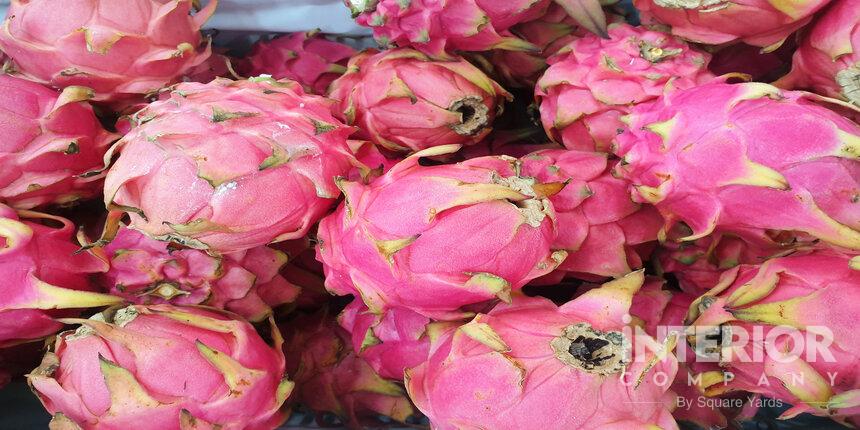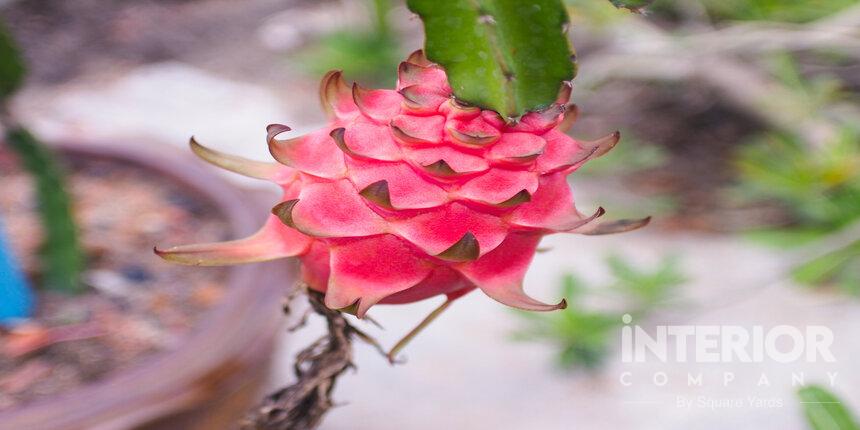- Kitchens
- Design Ideas
- Cities
- Trends
- Guides
- Price Calculators
- Our PortfolioNEW
- More
- Home
- Trends
- Furniture And Decor
- Indoor Plants
- Hylocereus Undatus Dragon Fruit Pitaya Indp
Dragon Fruit (Hylocereus Undatus) Propagation: Grow this Beautiful Succulent at Home
Hylocereus Undatus! Sounded like a spell from Harry Potter. Right? Well, well, hold your horses, it ain’t no spell! It’s a Dragon Fruit, which is also known as Pitaya. The plant nestles through tropical and subtropical regions of Israel, Malaysia, China, Vietnam, Nicaragua, and Thailand but India.
Table of Content
Now, you might be thinking- if this plant thrives in such regions, why am I even talking about it? After all, this succulent doesn't have much popularity in India. Agree? It's true but it doesn't imply that you can't grow it at your home. With the right planting tactics, this plant burgeons to be a weirdly beautiful creature adorned with a party of unalike fruits.
Therefore, if you are interested in growing such a unique shrub of your own, you must discover how to propagate a dragon fruit successfully. But before you take a plunge into the process of propagation, you must know a thing or two about Pitaya. So, let's start with the basics.
Dragon Fruit: A Quick Overview
| Commonly known as | Dragon Fruit, Red Pitaya, White-fleshed Pitahaya |
| Scientific Name | Hylocereus Undatus, Selenicereus Undatus |
| Family | Cactaceae |
| Order | Caryophyllales |
| Kingdom | Plantae |
| Habitats | An epiphytic or terrestrial plant, thriving in thickets, hedges, on rocks or rock walls, at altitudes up to 2,000 meters |
| Height | 4 m (13ft) by 2 m (6ft) |
| Varieties (that home-gardeners grow) | Hylocereus undatus, Hylocereus Megalanthus, Hylocereus Costaricensis |
| Origin | Not-known |
What is Dragon Fruit?
Dragon Fruit or Hylocereus Undatus is a cactus that branches out like vines and is often planted as a fruit crop and a night-flowering ornamental shrub. Amongst various nomenclatures, it is also known as Pitaya, Strawberry Pear, and Night-blooming Cereus. Dragon fruit is the English terminology for Pitaya and is a reflection of its Chinese name which literally signifies 'fire dragon fruit.'

Now, talking about the fruit, it is eminently embellishing, with bright red skin, covered with green scales. The fleshy and juicy white skin, with tiny crunchy black seeds, make the fruit deliciously flavourful. Although the exact native range of Hylocereus is still uncertain, people contemplate it to be in Central America.
Many tropical regions such as Vietnam, and various other South-East Asian countries have taken a commercial approach towards Dragon Fruit plantation. In countries like South Africa, Cuba, China, and on several islands in the Pacific Ocean, Pitaya Hylocereus Undatus is listed as an invasive weed.
What's more?
The plant produces a beautiful white flower having a strong scent. Besides, both the Hylocereus Undatus fruit and the Hylocereus flower are edible. Although, people generally prefer its fruit to eat.
The Hylocereus Undatus flower usually blooms at night, opens in the evening, and lasts until mid-morning the next day. The bell-shaped yellowish-green blossoms are highly aromatic and are about a foot long and 9 inches across. Typically, this succulent bears fruit during the summer.
So, this was enough about the plant, its fruit, origin, etc. Let us transition to the main primary topic of this blog i.e. propagation. But hey, before gorging onto that you must be aware of some prerequisites that the plant requires. So, let us first discover those obligations!
Factors to Consider Before Hylocereus Undatus Pitaya Propagation
We already know that this succulent plant thrives in tropical and subtropical climates but that's not all. You have to keep a close eye on a few things in order to have this shrub result into lush green. Go through the points listed below:
1: Hylocereus Undatus is a climbing cactus and hence, it needs some type of support to grow upon.
2: Although the plant is tropical and subtropical in nature and demands heat and sun, we advocate you to situate the new dragon fruit plant in an area receiving partial sun.
3: Pitaya hates cold weather and hence, can bear just a few spurts of frosts and freezing temps.
Now you might have a question here- what if you live in a cooler climate or in an apartment that doesn't have access to a garden? Fret not! You can still grow pitaya.
How?
Well, the plant is quite adaptable and grows well in a pot. In fact, the beauty of propagating this succulent plant in a container is the aptness of moving it and overwintering the plant indoors.
So, whether you live in a hot and humid temperate zone or in a cooler climate, you can grow this plant anywhere with the right conditions.
Now that you are finally familiar with the factors for plant growth, we can step into the propagation process.
How to Propagate Cactus Hylocereus (Dragon Fruit)?
Dragon fruits can be propagated in two ways: either from a) seed or b) stem cuttings. However, the propagation by stem cuttings is more preferred over the propagation from seed.
Why?
Because growing plants through seed demand a lot of patience and is less reliable. What's more intimidating is that it may take up to 7 years to bear fruit. Therefore, cultivation through the stem seems a more viable option.

But you can choose either way. It's completely up to you what you find the best. So, to ensure you proceed with the right method, we have covered the propagation from both seed and stem cuttings. Let us first cover the propagation through stem cuttings:
Propagation of Dragon Fruit through Stem Cutting
Growing Undatus through stem cutting is quite easy. You need to follow just three simple steps that are as follows:
Step 1: Obscure a stem segment of length 6 to 15 inches (or 12 to 38 cm).
Step 2: Cut the base of the stem making a slant and treat it with a fungicide. Then, leave the treated stem segment for 7 to 8 days in a temperate and shady area so that it can dry.
Step 3: Once the cutting has dried out, keep the segment into a rooting hormone and then plant it straight in a container filled with well-draining soil or in the garden. The cuttings will grow at a pace but you have to wait for 6 to 9 months from propagation for the plant to produce the fruit.
Wasn't this simple? Yes, it was. Now, let us find out how to grow Cactus Hylocereus through seeds.
Propagation of Dragon Fruit through Seeds
Although the process demands a hell of a lot of patience, people still employ it for good reasons. So, if you are one of them, follow these simple steps to grow a healthy and lush Hylocereus Undatus plant.
Step 1: Firstly, divide a dragon fruit into halves and scoop out the seeds using a spoon or anything handy.
Step 2: Put the halves into a bucket of water and separate the seeds from the pulp. Then, keep the seeds on a moist paper towel to dry overnight.
Step 3: The next day, take a tray and fill it with well-draining soil. Then, dredge the seeds onto the surface of the soil and sparsely cover them with a medium sprinkle.
Step 4: After covering the seeds, moisten the soil with a spray bottle and muffle with plastic wrap. Make a note that you have to keep the soil moist until germination that will occur in about 15 to 30 days.
Step 5: Once the seeds have sprouted, remove the plastic wrap and shift them to larger pots.
Yes, this is all you need to do. Not a big deal, right? Of course, but only until you follow the exact steps. Otherwise, the process won't bear any fruit.
Wrapping Up
Not a big drill! That's what we can conclude from the entire discussion in this blog. Agree? Although Hylocereus Undatus Cactus is a tropical and subtropical plant, it can be grown anywhere if planted or potted under the right conditions.
We also comprehended that we can propagate dragon fruit in two ways- either through seeds or through stem cuttings. However, stem cutting could be a more reliable choice as it doesn't require as much time as the seeds for propagation. Besides, cultivation through the stem is more likely to bear fruits in very little time. Think clearly and employ the one that suits your needs better.
Ready for a home transformation?
Let our designers assist you!
Recent Posts
Related Category
- Balcony
- Bedroom
- Home Decor
- Living Room
- Outdoors



































